A5M4 Claude
Advanced Kit
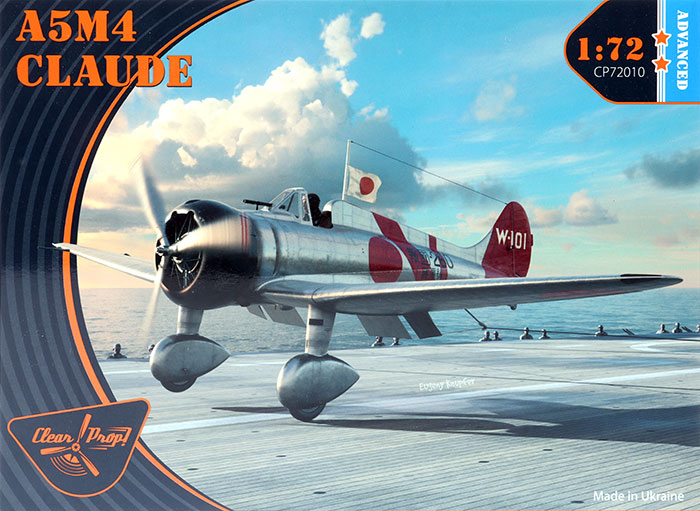
Clear Prop!, 1/72 scale
S
u m m a r y : |
Description and Item No.: |
Clear Prop! Kit No. CP72010 - A5M4 Claude Advanced Kit |
Contents and Media: |
84 parts in dark grey plastic (includes 11 marked not for use): five parts in clear ; one photo-etched fret with 37 parts; self-adhesive canopy masks; one decal sheet with four marking options. |
Price: |
19 Euro plus shipping available online from Clear Prop!
£22.50 EU Price (£18.75 Export Price) plus shipping available online from Hannants |
Scale: |
1/72 |
Review Type: |
First Look |
Advantages: |
Lovely crisp and subtle surface textures; high level of detail; includes photo-etched parts and masks. |
Disadvantages: |
Nothing worth mentioning. |
Recommendation: |
We are truly living in a new Golden Age of 1/72 scale aircraft models.
Clear Prop! joins others like Eduard, Arma, Airfix, Special Hobby, Zvezda and Dora Wings who are all breathing fresh life and setting a new high bar for small scale kits.
This is a very high quality offering that will appeal to small scale and Japanese pre-war and WWII naval aviation. |
Reviewed by Brett Green

The Mitsubishi A5M was a Japanese carrier-based fighter aircraft. It was the world's first low-wing monoplane shipboard fighter to enter service and the predecessor to the famous Mitsubishi A6M "Zero".
Its Allied reporting name was Claude.
Development
In 1934, Mitsubishi was assigned the task of designing a new naval fighter for the Imperial Japanese Navy.
The resulting design, designated Ka-14 by Mitsubishi, was an all-metal low-wing fighter, with a thin elliptical inverted gull wing and a fixed undercarriage, which was chosen as the increase in performance (estimated as 10% in drag, but only a mere 3% increase in maximum speed) arising from use of a retractable undercarriage was not felt to justify the extra weight.
The first prototype, powered by a 447 kW (600 hp) Nakajima Kotobuki 5 radial engine, flew on 4 February 1935. The aircraft far exceeded the requirements of the specification, with a maximum speed of 450 km/h (280 mph) being reached.
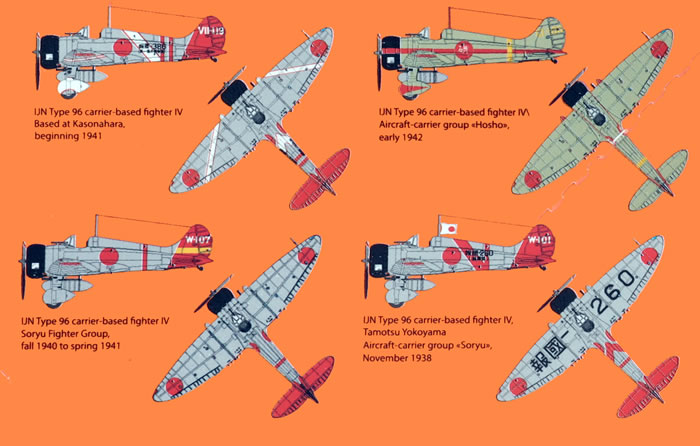
The second prototype was fitted with a revised, ungulled wing, and after various changes to maximize maneuverability and reduce drag, was ordered into production as the A5M.
Almost all A5Ms had open cockpits. A closed cockpit was tried but found little favor among Navy aviators. All had fixed, non-retractable undercarriage. Wheel spats were a feature of standard fighters but not training aircraft.
Operations
The aircraft entered IJN service in early 1937, and soon saw action in aerial battles at the start of the Second Sino-Japanese War including air-to-air combat with Republic of China Air Force's Boeing P-26C Model 281 "Peashooters" in the world's first aerial dogfighting and kills between monoplane fighters built of mostly metal.
Chinese Nationalist pilots, primarily flying the Curtiss Hawk III, fought against the Japanese, but the A5M had the better of almost every fighter aircraft it encountered. Though armed with only a pair of 7.7 mm (0.303 in) machine-guns, the new fighter proved effective and damage-tolerant, with excellent maneuverability and robust construction. Later on, A5M's also provided much-needed escorts for the then-modern but vulnerable Mitsubishi G3M bombers.
The Mitsubishi team continued to improve the A5M, working through versions until the final A5M4, which carried an external underside drop tank to provide fuel for extended range.
The A5M's most competitive adversary in the air was the Polikarpov I-16, a fast and heavily armed fighter flown by both Chinese Air Force regulars and Soviet volunteers. Air battles in 1938, especially on 18 February and 29 April, ranked among the largest air battles ever fought at the time. The battle of 29 April saw 67 Polikarpov fighters (31 I-16s and 36 I-15 bis) against 18 G3Ms escorted by 27 A5Ms. Each side claimed victory: the Chinese/Soviet side claimed 21 Japanese aircraft (11 fighters and 10 bombers) shot down with 50 Japanese airmen killed and two captured having bailed out while losing 12 aircraft and 5 pilots killed; the Japanese claimed they lost only two G3Ms and two A5Ms shot down with over 40 Chinese aircraft shot down.
The Flying Tigers encountered the Type 96, although not officially, and one was shot down at Mingaladon airfield, Burma on 29 January 1942.
Some A5Ms remained in service at the end of 1941 when the United States entered World War II in the Pacific. US intelligence sources believed the A5M still served as Japan's primary Navy fighter, when in fact the A6M 'Zero' had replaced it on first-line aircraft carriers and with the Tainan Kokutai in Taiwan.
Other Japanese carriers and Kokutai (air groups) continued to use the A5M until production of the Zero caught up with demand. On 1 February 1942, the US carrier USS Enterprise launched air strikes on Japanese air & naval bases on Roi and Kwajalein Atolls in the Gilbert Islands. During these actions, Mitsubishi A5Ms shot down three Douglas SBD dive-bombers, including the aircraft of Lt. Cdr. Halstead Hopping, CO of VS-6 Squadron.
The last combat actions with the A5M as a fighter took place at the Battle of the Coral Sea on 7 May 1942, when two A5Ms and four A6Ms of the Japanese carrier Shoho fought against US aircraft that sank their carrier.
In the closing months of the war most remaining A5M airframes were used for kamikaze attacks.
Clear Prop! released a 1/72 scale A5M2b Claude 1n 2019. This was followed by a Late Version A5M2b later in the same year.
They have now expanded their Claude family with a new A5M4 Claude Advanced Kit.
Clear Prop's 1/72 scale A5M4 Claude Advanced Kit comprises 84 parts in dark grey plastic (including 11 parts marked not for use), five parts in clear, one photo-etched fret with 37 parts, a self-adhesive white vinyl canopy masking sheet and a decal sheet with four marking options.
The plastic parts are moulded in dark grey plastic. The texture of the plastic is very smooth and sprue attachments are narrow.
Parts breakdown is perfectly conventional with port and starboard fuselage halves, full span lower wing half and separate parts for the upper port and starboard wing halves.
Surface details are fine, crisp and consistent. The panel lines and rivets lines are fine and crisply recessed.
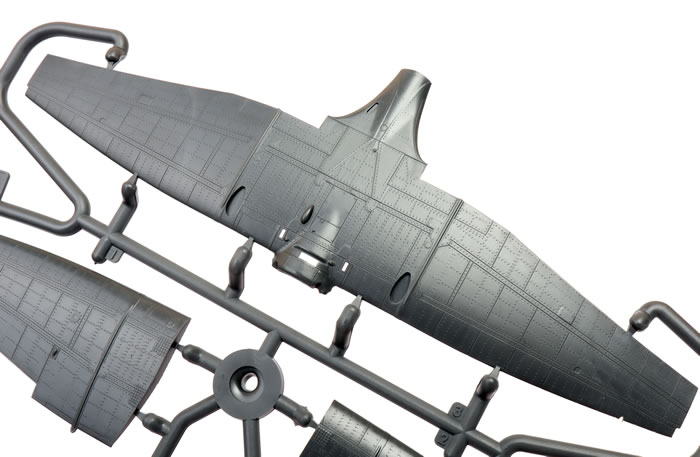
There is plenty of opportunity to see the surface textures on the wings and the fuselage. The effect is very impressive, espcially in this small scale.
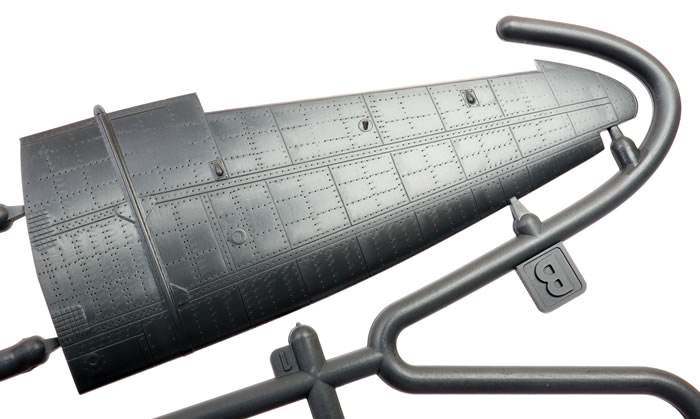
Fabric rendition on the control surfaces look good.
There is plenty of detail in the cockpit with photo-etched lap and shoulder straps plus instrument panel.
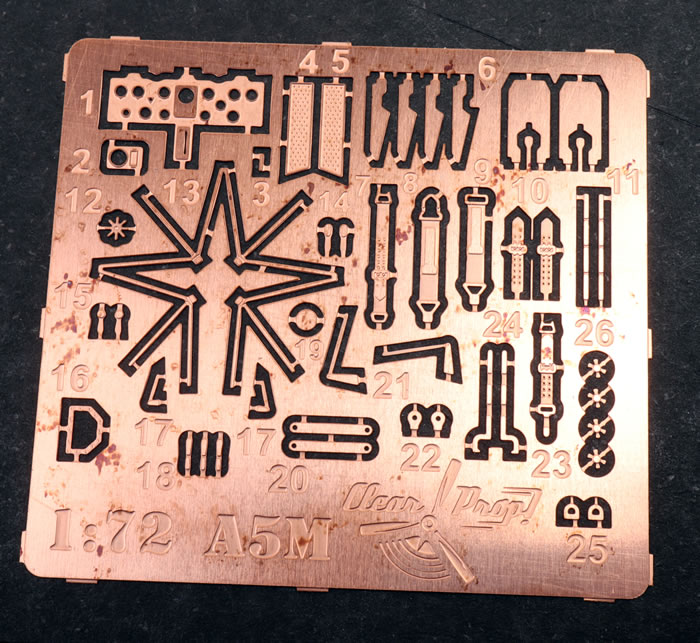
Sidewall structure is moulded onto the inside of the fuselage halves. The cockpit floor is a gorgeous little moulding too.
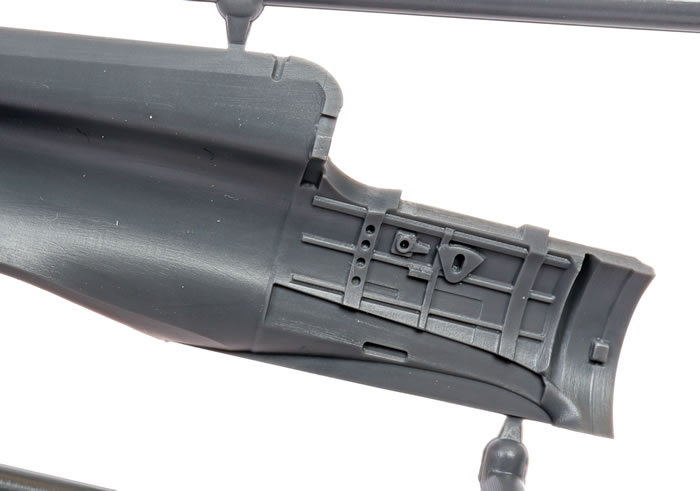
An alternative decal instrument panel is also offered for the plastic face although this is not mentioned in the instructions.
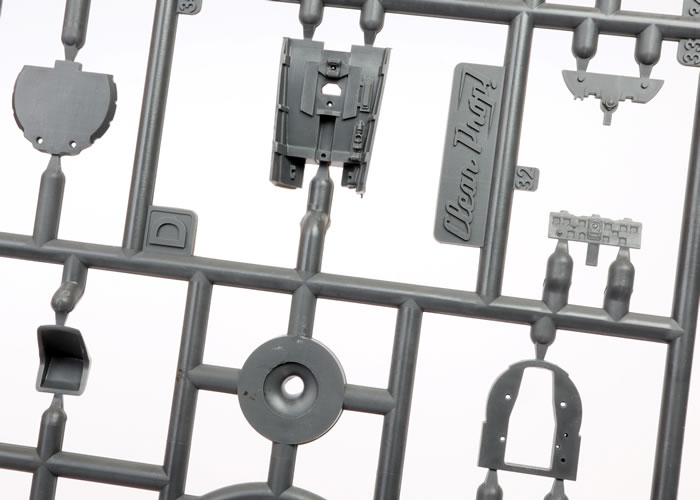
The Nakajima Kotobuki 5 radial engine and cowling are broken down into 13 parts plus a photo-etched bracing strut assembly.
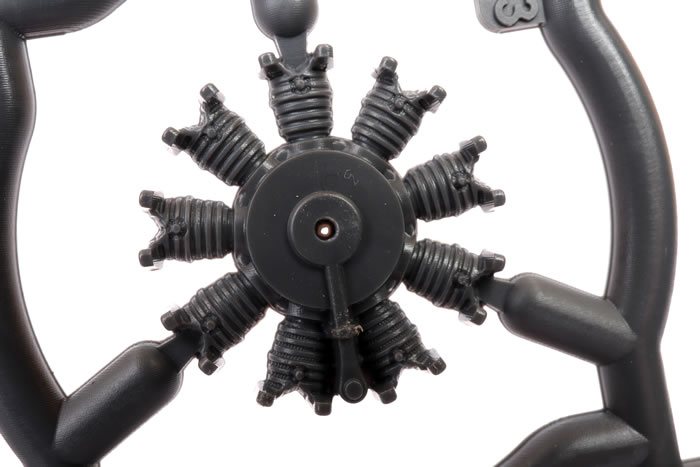
Ailerons and the rudder are separate parts and may be posed to taste. Elevators and flaps are moulded shut.
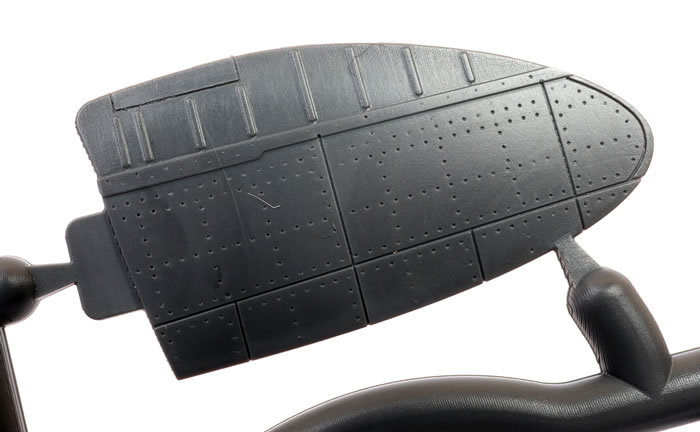
The undercarriage has spatted legs and separate wheels. Alternarive parts are supplied for unspatted legs but these are not applicable to the four marking options in this box.
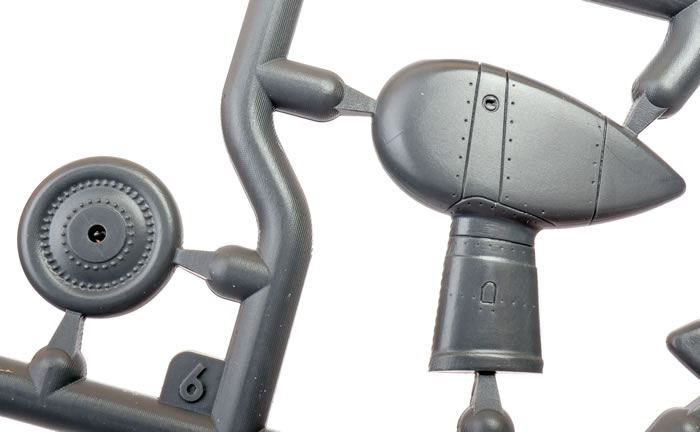
Options include an external centreline fuel tank and a camera gun.
The single-piece windscreen is nice and clear. The inclusion of self-adhesive white vinyl masks is very welcome. Cutting masks for this tiny windscreen would be tedious!
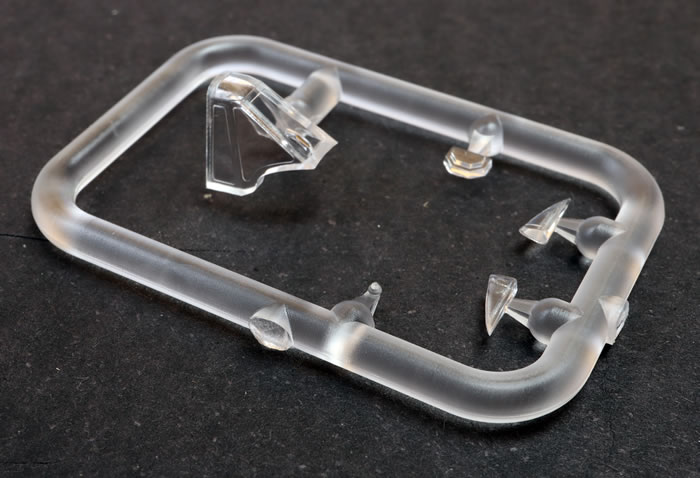
Instructions are generally clear and laid out over 18 steps in an eight page, folded A4 paper booklet.
The marking guide is in full colour and colours are called out throughout using Mr Color and MIG paint numbers. It might have been nice to have a few other paint brands cross-referenced too.
Markings
The colours and registration of the decals look good.
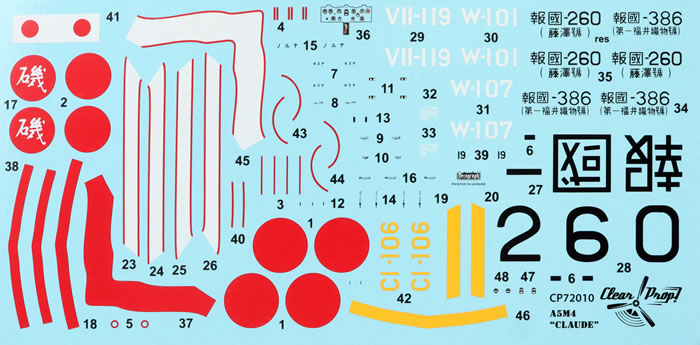
Four colourful marking options are offered:
-
three are finished in overall silver with various red, yellow and white stripes and markings.
-
the fourth option is finished in overall Hemp with a black cowling, plus red and yellow stripes.
We are truly living in a new Golden Age of 1/72 scale aircraft models.
Clear Prop! joins others like Eduard, Arma, Airfix, Special Hobby, Zvezda and Dora Wings who are all breathing fresh life and setting a new high bar for small scale kits.
This is a very high quality offering that will appeal to small scale and Japanese pre-war and WWII naval aviation.
Thanks to Clear Prop! for the sample
Text and Images Copyright © 2021 by Brett Green
Page Created 17 February, 2021
Last updated
18 February, 2021
Back to HyperScale Main Page
Back to Reviews Page
|
Home
| What's New |
Features |
Gallery |
Reviews |
Reference |
Forum |
Search